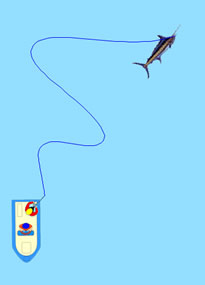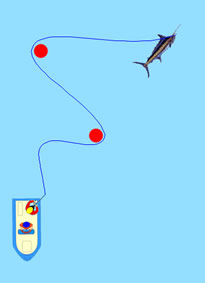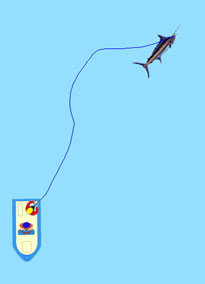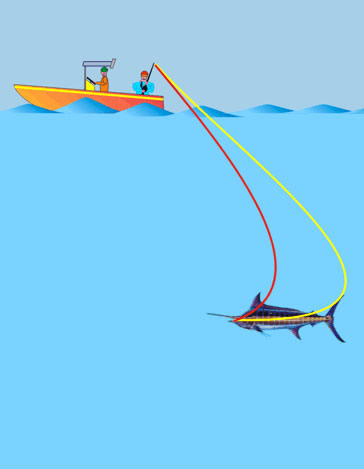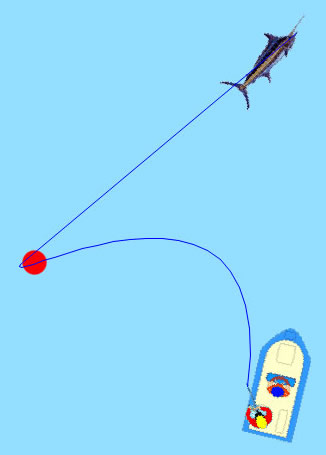06. Fighting Fish: Scenarios
Between The Lines - Ch: 12 Fighting Fish
|
Following are several scenarios that are quite common plus several points that are relevant to fighting fish that may help:
The Initial RunThe line will follow the course the fish takes. If the fish goes in a straight line so will the line and if the fish changes direction the line will follow the curve. How closely the track of the line follows the fish depends on how much drag is applied. The lower the drag setting, and the faster the fish is going, the more the line will follow the course of the fish. (Fig 1) On low drag settings, a fulcrum may form, in fact, several may form. This is where the line dramatically changes direction at a sharp angle. (Fig 2) There is a danger of breaking the line from sheer water pressure on the line. A sign that a fulcrum has formed is the fish seems to suddenly accelerate as the fulcrum acts as a pulley. To reduce the effects of the pulley increase drag to around 50 percent and raise the rod tip high to lift as much line out of the water as possible.
Note that when the reel is set to a third the initial strain on the line breaking the spool inertia is over 50 percent. As long as the spool is turning on a fish's run, it is quite safe to increase drag. You'll note a sudden decrease in what seems to be the speed of the fish, which is really the line beginning to take a more direct line with the fish. (Fig 3) As soon as the spool stops, back the drag off to 33 percent. At the other end of the line, the position of the leader and line is dictated by the thickness of the leader and line relative to the fish's speed and drag pressure. At high speed, the leader will lay along the length of the fish regardless of line and leader thickness. At slower speeds, the thinner the line and leader and the higher the drag pressure the more direct the line will be to the angler. (Fig 4) Chasing FishAfter the initial runs, the line follows the course the fish takes and is rarely in a straight line between the angler and fish. The initial stages of retrieving line is by following the course of the line, rather than the direction of the fish even if the course takes you up current of the fish.
By heading directly to the fish at this stage may increase the fulcrum or pivot point which could well increase the chance of breaking the line even if you are using quite low drag settings. (Fig 5) Once you have gained significant line and are relatively close to the fish, say approximately 100 yards, maneuver the boat back into position down current of the fish. The Head ShakeMany species of fish will try and dislodge hooks by violently shaking their heads from side to side. This is a natural and very effective tactic by the fish. There are many things you can do to try and prevent the fish throwing the hooks, however, none are very effective. The best you can hope for is try to keep line tight to the fish so that the stretch in the nylon and cushioning of the rod help to keep the hooks in, but not so much pressure that you aid the fish by pulling the hooks out. The amount of pressure that should be applied depends on how much line is between the angler and the fish and how much belly is in the line. The further away the fish is, the more pressure should be applied. The closer the fish the less pressure should be applied to the point that if the fish is very close, let the drag off and ‘bow the rod' to the fish. Fish Pointed at BoatThroughout the fight, you should never have the fish pointed directly at the boat. If it surges you will not be able to keep a tight line to it. If it jumps, it has a good chance of throwing the hooks, if it is close to the boat it puts the whole crew in danger of getting impaled if the fish jumps. Move the boat out of the way as quickly as possible if a fish is pointed at the boat. If this is done quickly the angler should back off the drag back to strike. Jumping and Surging FishOne of the most spectacular experiences in game and sports fishing is a fish going ballistic on the surface. As the fish jumps the line is lifted out of the water which reduces the water drag on the line, however, the speed of the fish as it re-enters may increase it significantly. If the fish is jumping away from the angler reduce drag and bow the rod if the fish is surging. If the fish is jumping at the boat, lift the rod tip to pull as much line out of the water and wind as fast as possible while the skipper drives the boat away. Both the angler and skipper should do their best to maintain a tight line to the fish. (Vid 1) Vid 1 If the fish is jumping or surging parallel with the boat increase drag to try and pull the belly out of the line to maintain pressure on the fish. If the line is tight, that is no belly, and surges are felt through the line, then back off the drag and bow the rod until you can regain control and resume smooth pumping and winding.
|





